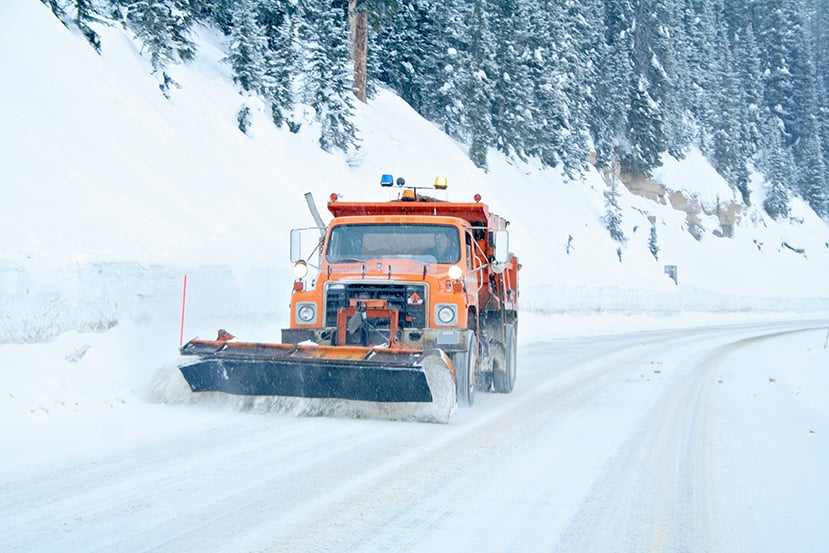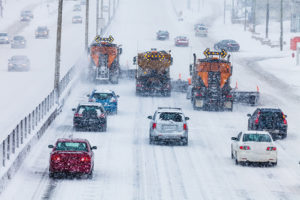
Every winter, the Utah Department of Transportation dispatches dozens of snowplows to keep driving conditions safe for motorists. Unfortunately, one of snowplow operators’ biggest struggles is being crowded or passed unsafely by passenger cars. This begs the question: is it legal to pass a snowplow in Utah? The shorter answer is yes. But to keep everyone safe on Utah roads, follow these tips when driving around snowplows.
Only Pass When Absolutely Necessary
It’s not illegal to pass snowplows, but it can be hazardous. UDOT encourages drivers to avoid passing snowplows altogether. When passing or driving next to a snowplow, you may get caught in the snow, ice, and debris that they are removing from the road. This can damage your car and increase your risk of crashing.
Additionally, plow blades are sharp and dangerous. According to Jake Brown at UDOT, these blades could tear a compact car open. If you attempt to pass a snowplow and find yourself skidding, you will be putting yourself, the snowplow driver, and everyone else on the road in danger.
Snowplows often travel under the speed limit, so it can be frustrating to be stuck behind one (or several). However, there’s a reason they’re out there– snow removal is a vital service. Keep in mind that the road in front and to the side of the snowplows will be extra snowy and icy. You’ll likely have to slow down after passing the plows anyway.
Never Pass on the Shoulder
If you absolutely must pass a snowplow, be sure to do so safely. Never pass on the right; plow trucks are designed to push snow and other debris to the right side of the road. Sometimes, they are equipped with a wingplow that crosses the line on the shoulder of the road. Wingplows can weigh as much as a compact car– if you accidentally hit one, you could damage your vehicle, seriously injure yourself, and endanger everyone on the highway.
If plows are driving in tandem formation (one in each lane of traffic, driving slightly behind or in front of each other), do not pass and refrain from changing lanes. You may encounter a snow cloud, which obstructs visibility. You may also pass over ridges of snow between lanes, which could cause you to lose traction.

If traveling on a two-lane road behind a single plow, you will need to wait until it is safe and legal to pass– wait for a passing lane or a dashed yellow centerline.
Do not ever attempt to pass a plow on the shoulder of the road. Shoulders are not subjected to the same ice removal as driving lanes, so you are far more likely to skid or spin out when driving on the shoulder.
Highway shoulders are also often covered in road debris that gets blown to the side as cars drive by. You may end up popping a tire on a nail or sharp object.
Give Snowplows Plenty of Room
Any time you drive in winter weather conditions, you should increase your following distance for all cars, not just plows. Typically, a safe following distance on snowy roads is at least 6-8 seconds.
It’s especially important not to tailgate snowplows. Plows regularly stop, back up, and/or drop deicer, such as salt brine. If you follow too closely, you may rear end the plow or get hit by deicing material. Give snowplows at least 3-4 car lengths of room. In heavy snowfall, give up to 200 feet of following distance.
Additionally, if you find yourself passing a snowplow driving the opposite direction, make sure you give them plenty of space to the side. Plow blades often cross the centerline and can hit your car if you aren’t paying attention.
Drive Safely for the Road Conditions
Keep everyone on the road safe by following these winter driving tips, whether you’re around snowplows or not:
- Leave early: Your commute on winter roads will likely take longer than usual. By giving yourself extra time, you can avoid the need to hurry.
- Check the forecast before you leave: If your travel isn’t absolutely necessary, avoid driving in winter storms.
- Slow down: The faster you are going, the more likely you are to lose control. Slowing down gives you more time to react to hazards in the roadway.
- Use your headlights: In a snowstorm or whiteout, your lights may be the only thing other drivers can see. Avoid using your brights, which may reflect off of the falling snow and blind you.
- Avoid sudden moves: When driving in winter weather conditions, jerking your steering wheel or slamming on your brakes can cause you to spin out.
- Stay alert: Pay attention to the road in front of you. If you come upon a hazard in the roadway, like a car accident or wildlife, you will need extra time to stop.
- Watch for flashing lights: In heavy snowfall, lights may be the only thing to alert you when you are coming upon a snowplow or the scene of an accident.
- Pay attention to and respect road closures: When roads are closed, it means the conditions are too dangerous for cars to use the roadway. Never attempt to drive on a closed road, even if it’s the fastest route to your destination. It will take much longer to get where you’re going if you get stuck.